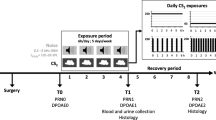Summary
In order to clarify the chronic effect of carbon disulfide (CS2) on the central nervous system (CNS), the brainstem auditory evoked potential (BAEP) was measured in spinning workers exposed to CS2 in a viscose rayon manufacturing factory and unexposed workers in Japan. Workers exposed to CS2 were divided into three groups according to length of exposure: current spinning workers with an exposure duration of more than 240 months (L group, n = 34), current spinning workers with an exposure duration of 24–84 months (S group, n = 25), and former spinning workers with an exposure duration of more than 120 months (R group, n = 16). Unexposed controls were selected from workers in a nylon filament factory using the same criteria (N group; n = 40). BAEP records were analyzed based on the latencies of three main components (I, III, V) and interpeak latencies (I–III IPL, III–V IPL, I–V IPL). Latencies of component V, III–V IPL, and I–V IPL in the L group were significantly greater (P < 0.01, P < 0.05, P < 0.05, respectively). The significantly, higher III–V IPL in the L group suggested that in humans, chronic exposure to CS2 involves the auditory ascending tract in the brainstem. Recovery from this neurotoxic effect is apparently possible, as the BAEP parameters in the R group were not significantly higher than those of the N group despite the long previous CS2 exposure of the R group.
Similar content being viewed by others
References
Cassito MG, Bertazzi PA, Camerino D, Bulgheroni C, Cirla AM, Gilioli R, Graziano C, Tomasini M (1978) Subjective and objective behavioral alteration in carbon disulfide workers. Med Lav 69:144–150
Chiappa KH, Gladstone KJ, Young RR (1979)Brainstem auditory evoked responses. Studies of waveform variation in 50 normal human subjects. Arch Neurol 36:81–87
Ginsburg SE, Pershai LK (1976) Clinico-electroencephalographic correlation in chronic carbon disulfide poisoning. Gig Trud Prof Zabor 6:16–20
Hanninen H (1971) Psychological picture of manifest and latent carbon disulfide poisoning. Br J Ind Med 28:374–378
Hanninen H (1974) Behavioral study on the effect of carbon disulfide. In: Xintaras C, Johnson BL, de Groot I (eds) Behavioral toxicology. Washington DC, US Department of Health and Education Welfare (NIOSH), Publication no. 74, 126, pp 73–78
Hirata M, Ogawa Y, Okayama A, Goto S (1992) Changes in auditory brainstem response in rats chronically exposed to carbon disulfide. Arch Toxicol 66:334–338
Lilis R (1974) Behavioral effects of occupational carbon disulfide exposure. In: Xintaras C, Johnson BL, de Groot I (eds) Behavioral toxicology. Washington DC, US Department of Health and Education Welfare (NIOSH), publication no. 74, 126, pp 51–59
Møller AR, Jannetta PJ (1986) Neural generator of the auditory brainstem response. In: Jacobson JJ (ed) The auditory brainstem response. College Hill Press, San Diego, pp 13–31
Proctor NH, Hughes HP (1988) Chemical hazards in the workplace. Lippincott, Philadelphia, pp 120–121
Putz-Anderson V, Albright BE, Johnson BL, Smith P (1983) A behavioral examination of workers exposed to carbon disulfide. Neurotoxicology 4:67–78
Robinson K, Rudge P (1982) Centrally generated auditory potentials. In: Hallidy AM (ed) Evoked potentials in clinical testing. Churchill Livingstone, Edinburgh, pp 345–392
Rouskova V (1975) Photic stimulation in early diagnosis of the effects of some harmful industrial substances on the central nervous system. Int Arch Arbeitsmed 34:283–299
Scherg M, Cramon DV (1985) A new interpretation of the generators of BAEP waves I–V: results of a spatio-temporal dipole model. Electroencephalogr Clin Neurophysiol 62:290–299
Seppäläinen AM, Hailta M (1980) Carbon disulfide. In: Spencer PS, Schaumberg HH (eds) Experimental and clinical neurotoxicology. Williams & Wilkins, Baltimore, pp 356–373
Seppäläinen AM, Tolonen M (1974) Neurotoxicity of long-term exposure to carbon disulfide in the viscose rayon industry — a neurophysiological study. Work Environ Health 11:145–153
Stockard JJ, Stockard JE, Sharbrough FW (1978) Non-pathologic factors influencing brainstem auditory evoked potentials. Am J Electroencephalogr Technol 18:177–209
Stybrova V (1977) Electroencephalography in diagnosis of early cerebral changes due to carbon disulfide. Int Arch Occup Environ Health 38:263–282
Author information
Authors and Affiliations
Rights and permissions
About this article
Cite this article
Hirata, M., Ogawa, Y., Okayama, A. et al. A cross-sectional study on the brainstem auditory evoked potential among workers exposed to carbon disulfide. Int. Arch Occup Environ Heath 64, 321–324 (1992). https://doi.org/10.1007/BF00379540
Received:
Accepted:
Issue Date:
DOI: https://doi.org/10.1007/BF00379540




